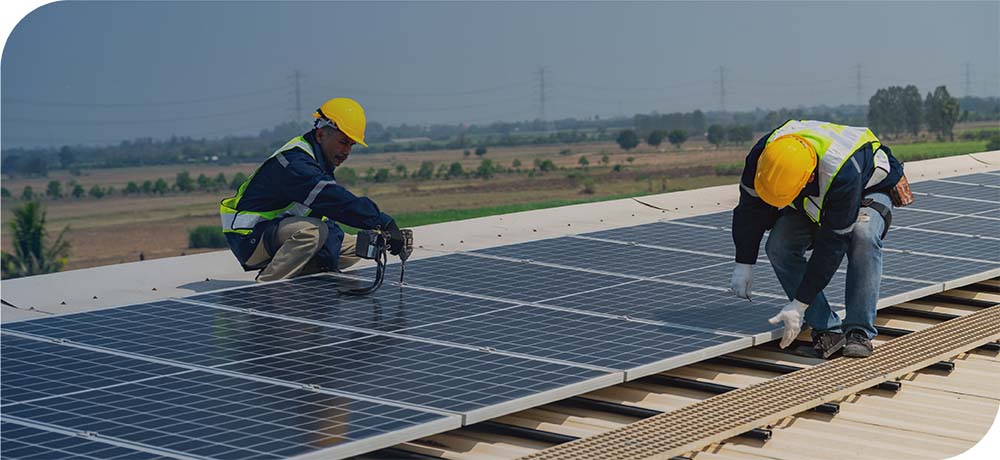Preventing the top 5 injuries on solar construction sites
The rapid growth in solar installations brings with it a critical responsibility of ensuring the safety of the workers who build this future. By focusing on the top five injuries, companies can create safer sites and protect their most valuable asset—their people.
Share This

The solar industry is a beacon of progress, driving our transition to a clean energy future. However, the rapid growth in solar installations brings with it a critical responsibility of ensuring the safety of the workers who build this future.
Solar construction sites present a unique combination of hazards from multiple trades, including rooftop work, electrical systems, heavy equipment and more.
By focusing on the most common injuries, companies can develop targeted strategies to protect their most valuable asset—their workforce.
Here are the top 5 injuries on solar construction sites and how to prevent them.
1. Slips, trips and falls
Slips and trips account for a majority of construction injuries. But they are also the most preventable hazards on the job.
By taking a few simple, proactive steps, you can help reduce hazards, protect yourself and your team, and keep the job site running safely and efficiently.
Prevention strategies:
- Warm up and stretch: Before you begin your tasks and after lunch breaks, ensure your body is adequately warmed up for the physical activity ahead.
- Wear the proper shoes: The proper footwear ensures you maintain your balance.
- Look out for potential hazards: Always clear your work area of debris, loose cords and other objects, never leave spills unattended or objects, never leave spills unattended or objects on stairways or ramps, and ensure your work area is properly lit.
- Take extra caution: Be extra careful when working on elevated surfaces and stay clear from the edge of unprotected floors and roofs. Use hand or safety rails when climbing and descending stairs.
2. Strains and sprains
Solar panels are heavy and awkwardly shaped, and solar work often requires walking across uneven terrain. Overexertion and repetitive lifting, twisting and handling can lead to painful back injuries, muscle strains and long-term musculoskeletal disorders.
Prevention strategies:
- Team lifting: Never lift a panel alone. Use a two-person (or more) team and communicate clearly.
- Proper lifting technique: Train workers on biomechanics: lift with the legs, keep the back straight and avoid twisting while carrying.
- Stretch and flex: Implement daily stretching routines to warm up muscles before the demanding work begins.
3. Cuts and lacerations
The materials used in solar construction are sharp. Panel frames, racking components and wiring can have burred metal edges. Handling them without proper gloves or care can result in serious cuts.
Prevention strategies:
- Mandate PPE: Cut-resistant gloves are non-negotiable. They should be provided and required for all handling of panels, racking and wiring.
- Proper handling techniques: Train workers to be aware of sharp edges and to handle materials deliberately.
- First aid ready: Have well-stocked first aid kits easily accessible on site and ensure crew members are trained in basic first aid.
4. Electrical shock
A solar array is akin to a live power plant. The current from panels is present as soon as the sun is shining and these currents are high-voltage. Contact with energized components can cause electrocution or severe burns.
Prevention strategies:
- Lockout/Tagout: This is the golden rule. Before working on any electrical system, circuits must be de-energized, verified with a multimeter and locked in the off position with a unique key held by the qualified worker.
- Qualified personnel only: Only trained and qualified electricians should perform electrical terminations and connections.
- Assume it’s live: Always treat every wire and connection as energized until proven otherwise.
5. Heat and cold stress
Solar work often happens in the elements, exposing crews to extreme temperatures that require specific safety measures.
In hot climates, prolonged exposure leads to dehydration, heat exhaustion, or heat stroke. In cold climates, workers are at risk of hypothermia, frostbite, and reduced dexterity.
Prevention strategies:
- Hydration: Encourage constant fluid intake. Provide cool, potable water on site and mandate regular breaks. In the cold, offer warm, sweet beverages to maintain core temperature and remind workers that hydration is just as critical as in the heat.
- Protected rest breaks: Set up climate-controlled areas for breaks. In the heat, use canopies or shaded areas. In the cold, provide heated trailers or tents to allow workers to warm up.
- Work scheduling: Adjust work schedules to avoid temperature extremes. In the heat, start earlier and work later to avoid the midday sun. In the cold, schedule the most demanding tasks for the warmest part of the day and be mindful of shorter daylight hours.
- Proper attire: Mandate appropriate clothing. For heat, recommend light-colored, loose-fitting, breathable fabrics and wide-brimmed hats. For cold, enforce the layering system (moisture-wicking base layer, insulating mid-layer, waterproof/windproof outer layer), insulated gloves, and warm, protective footwear.
- Training: Educate crews to recognize the signs of temperature-related stress in themselves and their coworkers. This includes heat stress (dizziness, headache, nausea, confusion) and cold stress (uncontrollable shivering, numbness, pale skin, fatigue, and disorientation).
Building a culture of safety
Preventing these top injuries isn’t just about rules—it’s about culture. It requires commitment from leadership, continuous training and empowering every worker to speak up if they see an unsafe condition.
Companies that invest in comprehensive safety programs not only protect their employees but also enhance productivity, reduce downtime and build a reputation as a responsible employer.
By focusing on these five critical areas, you can ensure that building a brighter energy future doesn’t come at a human cost.


